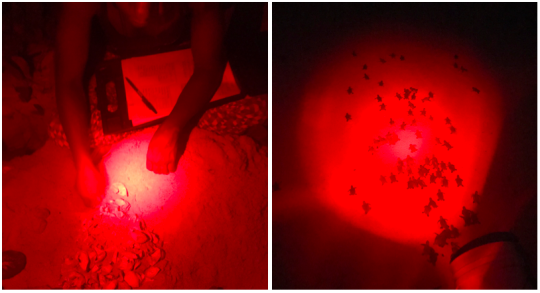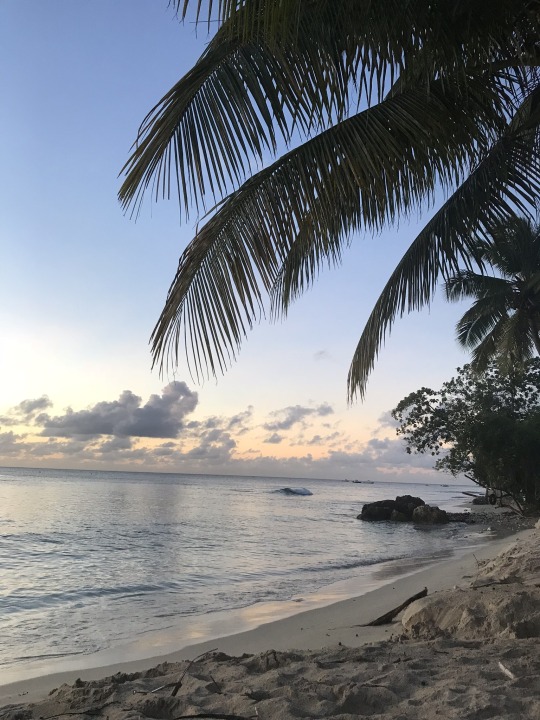By Ivon Vassileva
From chasing turtle hatchlings across beautiful beaches, to counting eggs and measuring the shells of big mama sea turtles, my fall semester has been nothing short of amazing. Last fall, I had the amazing opportunity to intern for six weeks with the Barbados Sea Turtle Project at the University of West Indies Cavehill. This organization deals with the conservation of the critically endangered marine turtle species that forage around and nest on Barbados, through research, education, public outreach, and monitoring of hatchlings and nesting females.

Hawksbill hatchlings on their way to the water.
Barbados is home to three sea turtle species. The hawksbill and leatherback turtles nest on the beaches and are critically endangered, while the green turtle feeds in near shore waters and is currently listed as endangered. These turtles are all extremely important nutrient transporters for both marine and land ecosystems. Most conservation efforts are targeted towards the hawksbill turtles, as up to 500 nesting females are found on the shores of Barbados every year, making it home to the second largest nesting population in the Wider Caribbean!
The primary reason for the declining sea turtle populations has been attributed to over-harvesting for their meat and eggs, as well as their shells, which are turned into jewelry. Although it is now illegal to harvest sea turtles in Barbados, other countries, like St. Lucia, still have open hunting seasons. In addition, turtles are often caught in fishing nets and long-line fishing gear, which causes them to drown before they can be released. Nesting beaches are also under threat, where turtles are forced to nest in sub-optimal locations due to the expansion of beachfront developments. Lastly, inland lights in Barbados disorient hatchlings, causing 75 to 90% of them to end up in pools, gardens, inside crab holes, or even as roadkill. The hatchlings already have a hard time as it is, since only 1 in every 1000 individuals survives to adulthood, even in optimal conditions!

Hawksbill sea turtle hatchling.
The Barbados Sea Turtle Project consists of beach patrolling in order to record nesting and hatchling emergence events, tag nesting females, collect morphometric and environmental data, and of course, rescue stranded turtles. During my time there, I was able to not only help out with the patrolling effort, but also to contribute to two exciting and novel projects.
The goal of the first project was to measure sand temperatures across a gradient, in the open beach and under low and high vegetation, in order to try to relate different sand characteristics to the temperatures recorded. Eventually, this data in combination with nesting data will be used to determine the kinds of beaches that exhibit high hatchling success rate and are preferred by turtles. The factors we investigated included the sand albedo, size grain distribution (i.e., the proportion of sand made up of different size classes from 0.0063mm to < 2mm), water retention, shape of particles, and were correlated to temperature data obtained from buried data loggers. Preliminary results suggest that shade from high vegetation leads to coolest sand temperatures, whereas low lying vegetation results in hottest sand temperatures. Additionally, while size grain distribution seemed equal across the beaches, different coast lines varied in the colour and shape of their sand particles. These results should be taken into consideration when planning beachfront property construction or turtle nest relocation attempts

(a) Turtle nest excavation to assess survivorship and help any stranded hatchlings. (b) Release of previously disoriented hatchlings from excavated nest.
The second project involved the collection of sand samples from a prominent turtle nesting beach where a new hotel development is to be built. The construction plan includes the addition of modified sand (i.e., sand created by crushing down limestone) to the beach in order to increase beach width. However, this modified sand has not been previously tested on any beach, and its effects on hatchlings and nesting females remain unknown. Hence, I helped establish a sand sampling protocol and analyzed several natural sand samples. As this is a new study, the organization will continue to monitor the beach with the addition of the modified sand. Results will hopefully shed light on how this modified sand impacts sea turtles, and whether it is a viable option for other beach design plans around the world.
Overall, my time in Barbados was truly amazing. Working with an incredible group of people and contributing to such an important conservation effort has been one of the most rewarding aspects of my graduate studies so far.

Sunset over the west coast of Barbados.
To volunteer, donate, or learn more about sea turtles and the Barbados Sea Turtles Project, check out their webpage: www.barbadosseaturtles.org

Ivon Vassileva is a MSc student at McGill University supervised by professors Simon Reader and Rachel Page. Her thesis focuses on grouping and learning behavior in the Trinidadian guppy, however she has also been involved in various other projects including chipmunk foraging behavior, bat temperament and sea turtle conservation!

0 Comments